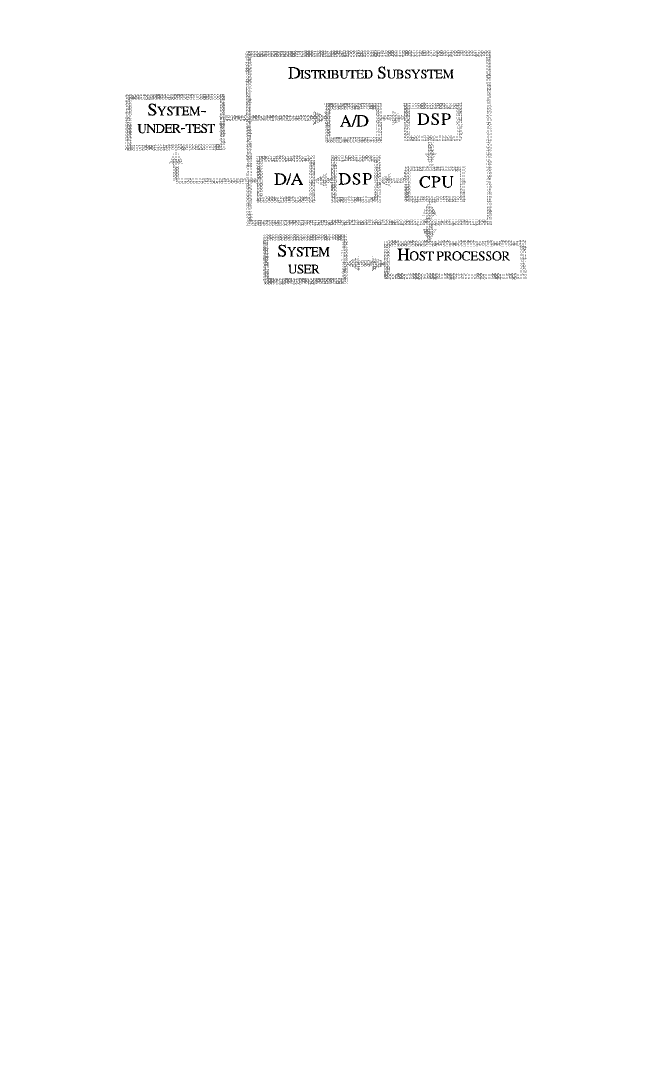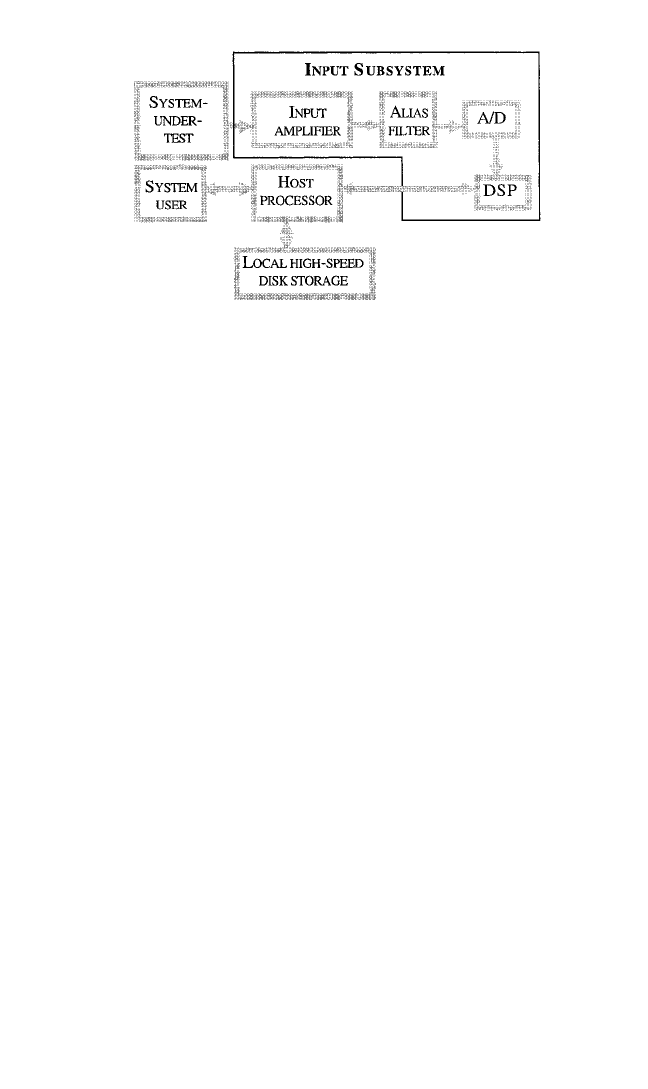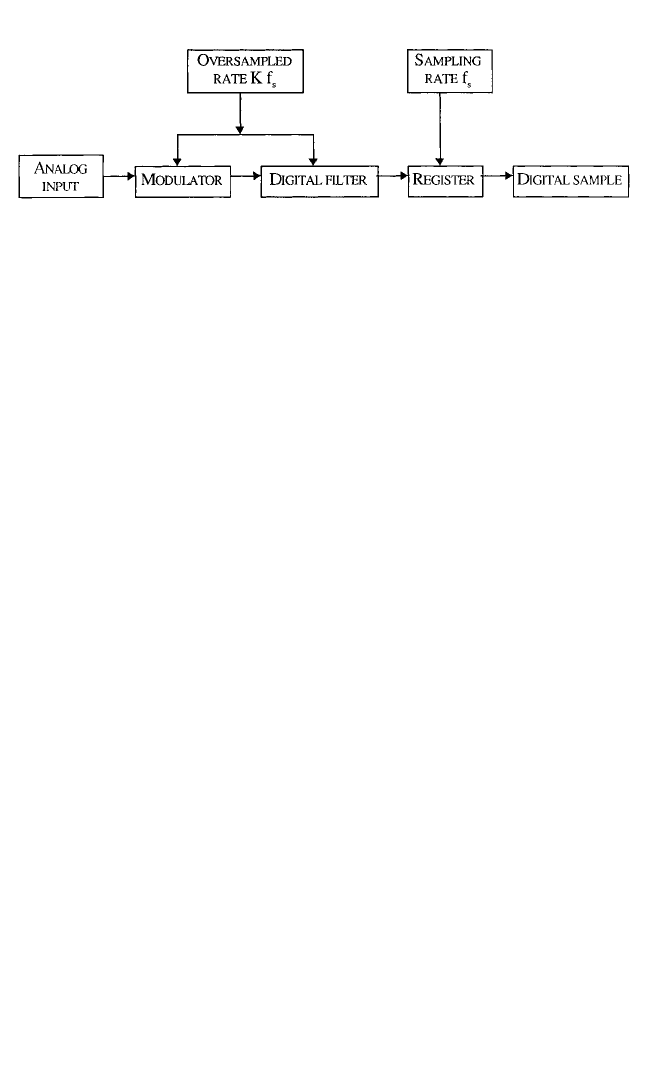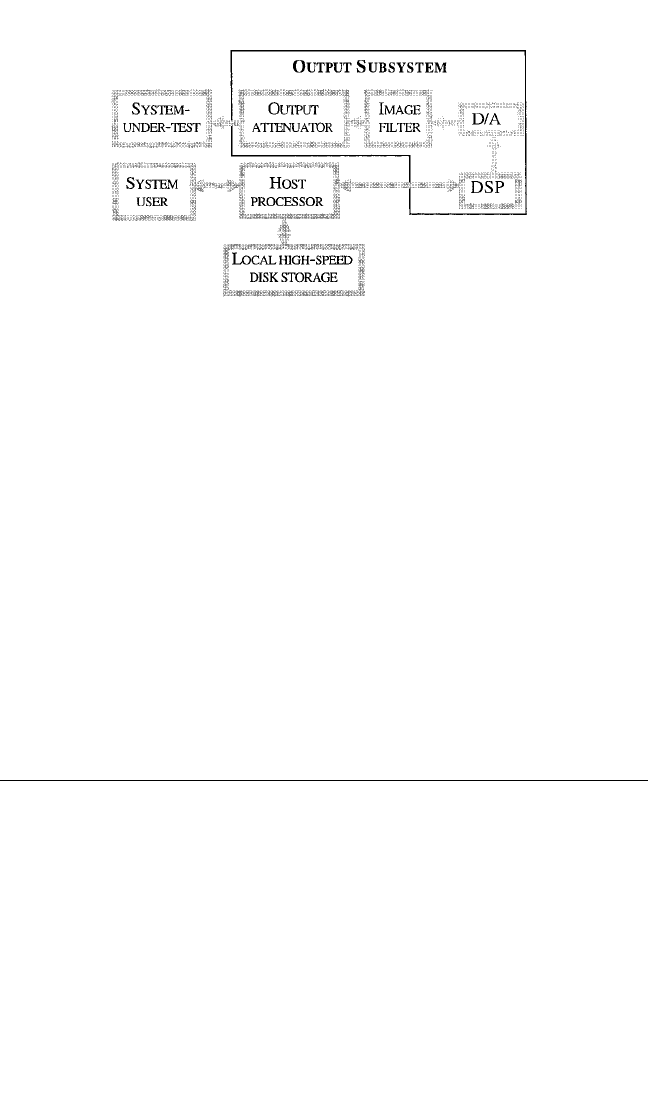Harris C.M., Piersol A.G. Harris Shock and vibration handbook
Подождите немного. Документ загружается.


tions. This type of digital computer system is an outgrowth of electronic organizers.
They are small enough to fit in a shirt pocket, are battery-powered, have small
screens, and thus are useful for note-taking, simple calculations, simple word pro-
cessing, and Internet access. They support simplified versions of popular personal
computer applications with many also supporting handwriting and voice recogni-
tion. They can be employed in the shock and vibration field as remote data gather-
ers that can connect to a host computer to transfer the acquired data to it for further
processing.The host computer is typically a personal computer or workstation.
SPECIALIZED PROCESSORS
Specialized processors are designed for a particular activity or type of calculation
that is being performed.They consist of embedded, distributed, digital signal proces-
sors, and reduced instruction set computer processor architectures. These systems
typically afford the most performance for shock and vibration applications, but at a
higher level of complexity than that associated with the general purpose computers
that were previously discussed. Included in this category are specialized peripherals
such as analog-to-digital (A/D) converters and digital-to-analog (D/A) converters
that provide the fundamental interfaces between computer systems and physical
systems like transducers and exciters, which are used for many shock and vibration
testing and analysis applications. Specialized processor architectures are used exten-
sively in shock and vibration experimental applications, since they provide the nec-
essary power and structure to be able to accomplish some of the more demanding
applications like the control of single or multiple vibration test exciters, or applica-
tions that involve the measurement and analysis of many response channels from a
shock and vibration test.
Embedded Processors. Embedded processors are computer systems that do not
interact directly with the user and are used to accomplish a specialized application.
This type of system is part of a larger system where the embedded portion serves as
an intelligent peripheral for a general purpose computer host like a workstation or
personal computer–based system. The embedded subsystem is used to perform
time-critical functions that are not suitable for a general purpose system due to lim-
itations in its operating systems. The operating system used for embedded proces-
sors is optimized for real-time response and dedicated, for example, to the signal
synthesis, signal acquisition, and processing tasks. The embedded system typically
communicates with the host processor through a high-speed interface like Ethernet,
small computer system interconnect (SCSI), or a direct communication between the
memory busses of the embedded and host computer systems. An embedded com-
puter system does not interface directly with the computer system user, but uses the
host computer system for this purpose. An example of an embedded system, which
uses distributed processors, is shown in Fig. 27.1. Here the host computer is used to
set the parameters for the particular activity, for example, shock and vibration con-
trol and analysis, and uses the embedded computer subsystem to accomplish the
control and analysis task directly. This frees the host processor to simply receive the
results of the shock and vibration task, and to create associated graphic displays for
the system user.
Distributed Computer Systems. Distributed computer systems are digital com-
puters that accomplish their task by using several computer processor systems in
tandem to solve a problem that cannot be suitably solved by an individual computer
27.4 CHAPTER TWENTY-SEVEN
8434_Harris_27_b.qxd 09/20/2001 11:51 AM Page 27.4

or processor system.This type of computer system typically partitions its task in such
a way that each part can be executed in parallel by its respective processor. This
enables the use of several specialized processors to separately accomplish a
demanding subtask, and thus the overall shock and vibration task, in a way that may
not be possible with the use of a single general purpose computer system.
An example of this type of system, as shown in Fig. 27.1, is a distributed and
embedded computer system that uses digital signal processors to process data being
received from an A/D converter by filtering it and extracting the pertinent signal
characteristics needed as part of a shock and vibration test.This filtered data, and its
extracted characteristics, are subsequently sent to a more general processor to per-
form additional analysis on the data. The results of this more general analysis may
yield a time-series data stream that is sent to another digital signal processor for fil-
tering, and then sent to an output D/A converter to produce signals that are used to
excite a system under test. Figure 27.1 also shows, in the form of a block diagram, a
typical form and application of a distributed and embedded subsystem as it would be
used in a shock and vibration test. A specialized embedded operating system is typ-
ically used by the distributed system’s central processing unit (CPU) to coordinate
the communications between and with the two digital signal processor subsystems.
The host processing system is used to interface with the overall system’s user.
Digital Signal Processors. Digital signal processors (DSPs) are specialized
processors that are optimized for the multiply-accumulate operations that are used
in digital filtering and linear algebra–related processing. They are used extensively
in shock and vibration signal analysis and vibration control systems. These proces-
sors are ideal to implement digital filters, for sample-rate reduction and aliasing pro-
tection
1
(see Chap. 14), fast Fourier transform (FFT)–based algorithms (see Chap.
22), and digital control systems. Linear algebra problems, like those encountered in
signal estimation, filtering, and prediction, are also performed efficiently by this
architecture.
2,3
The previous example of an embedded and distributed system in Fig.
27.1 also shows a typical application of DSP technology. The development of this
digital computer architecture has empowered much of the audio and video signal
processing systems in current use. It has also enabled many of the shock and vibra-
tion experimental applications now in use.
Reduced Instruction Set Computer. Reduced instruction set computer (RISC)
systems are computer systems based on specialized processors that are optimized to
execute their computer instructions in a single CPU cycle. In order to execute
APPLICATION OF DIGITAL COMPUTERS 27.5
FIGURE 27.1 Diagram of distributed and embedded system.
8434_Harris_27_b.qxd 09/20/2001 11:51 AM Page 27.5

instructions in a single cycle, these processors typically are designed to execute only
simple instructions at a higher rate than is possible with complex instruction set com-
puters (CISCs) like those used in many personal computer and mainframe computer
systems. Current RISC systems also have multiple execution units that are part of
the CPU and thus can execute several instructions in parallel. Such systems are
called super-scalar RISC systems. RISC systems also have large internal memories,
within the processor’s integrated circuits, that are called cache memories, that keep
the most recently executed instructions and data.This further speeds the computer’s
ability to execute instructions. Floating point instructions are also heavily optimized,
which give this type of processor an advantage for shock and vibration applications.
However, CISC processors are evolving. They are incorporating the best ideas from
RISC designs and, as time passes, these two types of computer architectures will
tend to merge.
RISC processors were originally developed for high-powered workstations that
run the UNIX operating system. Now they are being used more in the embedded
application arena for things like digital video, sophisticated game consoles, and
increasingly in experimental applications for shock and vibration in systems like the
example embedded system shown in Fig. 27.1. In these systems, the embedded and
distributed system CPU is typically a RISC processor running an embedded real-
time operating system (RTOS) to coordinate its activity and the activities of the
other specialized processors that are used, as in Fig. 27.1.
A/D and D/A Converters for Signal Sampling and Generation. A/D and D/A
converters are fundamental to the applications of digital computers to the field of
shock and vibration. They provide a fundamental interface between the analog
nature of shock and vibration phenomena and the digital processing available from
modern computing systems. These important subsystems are now realized by single
integrated circuits (ICs), often incorporating most of the filtering needed for
antialiasing (see Chaps. 13, 14, and 22) for A/D converters, and anti-imaging for D/A
converters. This is particularly true of those A/D converters that use sigma-delta
(Σ∆) technology, which employs (1) simple analog signal preprocessing, (2) an inter-
nal sampling rate that is much higher than the signal’s frequency bandwidth, (3)
internal low accuracy A/D and D/A converters coupled with advanced feedback
control processing, and (4) internal digital signal processing to reduce the output
sampling rate and increase the output signal’s resolution.
4
In practice, even when
using Σ∆ technology, additional analog circuitry is needed to complete the antialias-
ing and anti-imaging function, and also to add needed signal amplification and con-
ditioning to more fully utilize the resolution of modern A/D and D/A converters.
A/D Converters and Data Preparation. A/D converters furnish the analog-to-
digital conversion function, which is the process by which an analog (continuous)
signal is converted into a series of numerical values with a given binary digit (bit)
resolution (see Chap. 22). This is the first step in any digital method. The A/D con-
verter operation is generally built into self-contained digital analysis systems that
use the A/D converter subsystem as a peripheral. The main CPU within the digital
analysis system is typically a personal computer or a high-performance workstation.
This CPU is used to set up the A/D converter’s data-acquisition parameters such as
the sampling rate, input-voltage range, frequency range, input data block size (dura-
tion of signal to be digitized), and the number of data blocks to be digitized. The
acquired data may then be subsequently analyzed offline by the digital analysis sys-
tem, or in real-time as the test progresses. Examples of A/D converter applications
are shown in Figs. 27.1 and 27.2. If the digital processing is to be performed on a
general-purpose scientific computer at another facility, then the data is captured to
27.6 CHAPTER TWENTY-SEVEN
8434_Harris_27_b.qxd 09/20/2001 11:51 AM Page 27.6

local storage on the digital analysis system so that it can then be transported to the
remote scientific computer, either by hard disk, by the Internet, or by other facility
methods or networks.
A prime advantage of digital analysis methods is that the time-history needs to be
digitized with an A/D converter and digitally recorded only once. Subsequently, the
recorded data can be analyzed using various methods and at various times. Some-
times, the need to digitally record a time-history may be omitted if only real-time
interactive signal analysis is needed. However, if the test data is digitized and stored
during a test using real-time signal analysis, the problems associated with not antici-
pating the need for a particular signal analysis result during a test can be avoided by
being able to reanalyze the test data that was digitally recorded.
In Fig. 27.2, the input signal from the system under test is amplified by the input
amplifier to maximize the A/D converter’s resolution. The amplified signal is then
filtered to remove high-frequency energy in the input signal that could be aliased
(see Chap. 22), and then is passed to the A/D converter for digitization. The digital
time series that the A/D converter produces is then sent to a digital signal processor
for additional filtering and perhaps sample-rate reduction, or other needed special-
ized processing before it is sent to the host processor. For each input channel, the
combination of (1) the input amplifier, (2) the antialiasing filter, (3) the A/D con-
verter, and (4) the DSP, is called the input subsystem and is used by digital vibration
control systems to be discussed later.
The integrated circuits in many A/D converters, such as those shown in Figs. 27.1
and 27.2, employ Σ∆ technology.
4
The technology uses oversampling techniques to
provide a higher oversampling ratio (the sampling frequency divided by the highest
frequency of interest). This reduces the need for complexity in the antialias filter
from that required for more conventional A/D converters, which use a lower over-
sampling ratio, like 2.56, and thus need complex antialias analog filters with very
narrow transition bands
1,4
(the frequency region between the filter’s cutoff fre-
quency and the start of its stopband). Σ∆ A/D converters are typically implemented
as shown in Fig. 27.3, which illustrates their usual structure in the form of a block
diagram.
In Fig. 27.3, the Σ∆ modulator (the device that converts the analog input into its
digital representation) and digital filter
1
operate at sampling rates K times higher
than the A/D converter’s output sampling rate f
s
in samples per second (sps). In this
example, the oversampling ratio of the modulator is K. The digital filter reduces the
APPLICATION OF DIGITAL COMPUTERS 27.7
FIGURE 27.2 Diagram of typical A/D converter–based input
subsystem.
8434_Harris_27_b.qxd 09/20/2001 11:51 AM Page 27.7

sampling rate from that used in the modulator section to f
s
by successively filtering
and decimating, usually in stages, to reduce the complexity of the digital filter. Most
current A/D converter designs can provide alias-free output samples at an f
s
that is
2.2 times the highest frequency of interest (the acquisition bandwidth). For example,
if the A/D converter is operated with a 51.2 ksps sampling rate, then its output will
be alias-free for an acquisition bandwidth (ABW) of 23.27 kHz. However, most dig-
ital systems used for shock and vibration testing applications, for example, typically
process the data with an ABW of 20 kHz, thus using an effective oversampling ratio
of 2.56.The modulator typically performs the initial sampling of the analog input sig-
nal with an internal oversampling ratio of 64, which results in an internal oversam-
pled rate of 3.2768 Msps (64 times 51.2 ksps). The use of this internal sampling rate
results in signal values that will alias if their frequency is above the Nyquist fre-
quency f
A
, defined as one-half the sample rate, that is, f
A
= f
s
/2 (see Chap. 22). How-
ever, only frequencies higher than 3.2568 MHz will alias into the 20 kHz ABW of
this example.
13,31
The antialias filter thus only needs to attenuate signal frequencies
larger than 3.2568 MHz to ensure alias-free data below 20 kHz, and thus can have a
transition bandwidth from 20 kHz to 3.2568 MHz.
4,5
Since the complexity of the
needed antialiasing filter is largely determined by the narrowness of its transition
bandwidth, this large resultant transition bandwidth, which corresponds to the large
oversampling ratio of 64, significantly simplifies the design of the needed antialias
filter. Higher-signal ABWs can be obtained by operating the A/D converter at a
higher sample rate. Output sample rates as high as 204.8 ksps, while maintaining
good low-frequency performance, are becoming available, which provide an ABW
of 80 kHz when using a 2.56 oversampling ratio.
The modulator
4
of the A/D converter shown in Fig. 27.3 is at the heart of the A/D
converter design, and thus its structure is an important determinant of its resultant
performance. An example of its internal structure is shown in Fig. 27.4, which pres-
ents an example of a first-order
4
modulator. Such first-order modulators show the
basic ideas underlying Σ∆ technology. However, many current Σ∆ A/D converters
employ higher-order modulators. These higher-order modulators use a number of
integrators, as shown in Fig. 27.4, equal in number to the order of the Σ∆ modulator.
These are either used in a cascade of first-order modulators, as in Fig. 27.4, or as a
combination of integrators that are used in a multiple feedback loop, equal to the Σ∆
modulator order,
4
again as shown in Fig. 27.4.
At the input of the modulator shown in Fig. 27.4, there is a comparator that com-
pares the value of the output voltage of the low-bit D/A converter and the analog
input voltage, and passes this difference to an integrator.The integrated error voltage
is passed to a low-bit A/D converter, typically with the same number of bits as the
D/A converter, usually 1 or 2 bits, which then makes a digital output available from
the Σ∆ modulator at its oversampled rate. The short-term averages of this low-
resolution digital output sample can be made very close in value to the digitized value
27.8 CHAPTER TWENTY-SEVEN
FIGURE 27.3 Oversampling sigma-delta (Σ∆) A/D converter.
8434_Harris_27_b.qxd 09/20/2001 11:51 AM Page 27.8

of the analog input at a given bit resolution.
4
The digital filter that follows the Σ∆
modulator in Fig. 27.3 is designed to both average these samples and thereby increase
their digital resolution, as well as reduce their sample rate while performing as a dig-
ital antialiasing filter.
4
The digital filter also causes delay effects in Σ∆ A/D converters
that can cause problems when used with digital vibration control systems. This is due
to the digital filter’s group delay,
1,4
which is typically on the order of 34 samples, and
which can cause closed-loop stability problems if not addressed properly.
D/A Converters and Signal Synthesis. As discussed previously, D/A converters
convert a digital time series into an analog signal. This analog signal will have a
“staircase” or zero-order hold nature.
5
This occurs because the D/A converter out-
put signal is held constant for an output sample-rate period, and then is changed
according to the next digital sample at the next sample-clock period. This staircase
nature of the output D/A converter signal causes its analog output signal spectrum
to have high-frequency terms, in addition to those present in its digital time series
spectrum, with their frequency content centered about the D/A converter’s sample-
rate frequency, both below the sample rate and above the sample rate, and its inte-
ger multiples.
5
These somewhat symmetrical spectral lobes that appear in the D/A
converter output signal spectrum, and that are centered at the sample-rate fre-
quency and its harmonics, are called signal images.
5
These spectral lobes have a
bandwidth double that of the bandwidth of the digital time series that is being sent
to the D/A converter.
5
The spectrum of these signal images has a sin(x)/x envelope
that is due to the zero-order hold nature of the D/A converter. They are the coun-
terpart to aliasing that occurs with A/D converter sampling (see Chap. 22). These
signal images should be removed before using the D/A converter output signal to
excite a system under test. For this reason and others, the output subsystem should
be organized as is shown in Fig. 27.5.
In Fig. 27.5, the signal flow is the reverse of that for the A/D converter–based input
subsystem, as shown in Figs. 27.1 and 27.2. In Fig. 27.5, the output signal flows from a
local high-speed disk storage subsystem into the host processor, which formats it for
the digital signal processor in the output subsystem. The digital signal processor per-
forms some filtering and perhaps increases the sample rate to minimize the impact of
output signal images, moving them higher in frequency and lower in amplitude. This
filtered and processed output time series is then sent to the D/A converter to produce
an analog voltage.The D/A converter output voltage is filtered by an anti-imaging fil-
ter to remove any signal images that may still be present. This filtered signal is then
passed to the output attenuator subsystem to set the final output signal amplitude.
The attenuator is used to maximize the D/A converter output resolution. Typically,
additional output filtering is provided by the analog circuitry that is part of the atten-
uator. Digital vibration control systems use the output subsystem shown in Fig. 27.5.
APPLICATION OF DIGITAL COMPUTERS 27.9
FIGURE 27.4 Typical first-order Σ∆ modulator.
8434_Harris_27_b.qxd 09/20/2001 11:51 AM Page 27.9

Σ∆ D/A converter IC designs are also used for shock and vibration applications.
They use an internal signal flow that is the reverse of that for a Σ∆ A/D converter, as
shown in Fig. 27.3, but are otherwise very similar.
4
It uses digital filters for output
interpolation and to increase the sampling rate from the system sampling rate to an
oversampling rate. This digital filter also causes group delay effects like those dis-
cussed for Σ∆ A/D converters. At this oversampling rate, a low-bit resolution D/A
converter output is produced, but at this high output sample rate, the signal image
filter shown in Fig. 27.5 is also simplified since the D/A converter signal images are
now centered at the oversampling frequency, which is typically 3.2768 MHz, instead
of the output sample rate frequency which is typically 51.2 kHz. As in the Σ∆ A/D
converter case, this results in a large transition bandwidth image filter. The low-bit
D/A converter output is filtered by the image filter to remove the signal images that
are still present. The image filter also acts like a short-term averager, and thus a
higher effective D/A converter resolution is obtained, again as in the associated dis-
cussion on Σ∆ A/D converters. For the Σ∆ D/A converter, the major design and
research efforts are in the Σ∆ de-modulator
4
section (the device that converts the
digital representation of the output signal into an equivalent analog output).
ANALYTICAL APPLICATIONS
The development of large-scale computers with a very short cycle time (i.e., the time
required to perform a single operation, such as adding two numbers) and a very
large memory permits detailed analyses of structural responses to shock and vibra-
tion excitations. In this chapter, programs developed to perform these analyses are
categorized as general-purpose programs and special-purpose programs. References
3, 6, and 7 contain extensive discussions of both general-purpose and special-
purpose analytical programs.
GENERAL-PURPOSE PROGRAMS
Programs may be classed as general-purpose if they are applicable to a wide range of
structures and permit the user to select a number of options, such as damping (vis-
cous or structural), and various types of excitations (sinusoidal vibration, random
vibration, or transients).
27.10 CHAPTER TWENTY-SEVEN
FIGURE 27.5 Typical D/A converter–based output subsystem.
8434_Harris_27_b.qxd 09/20/2001 11:51 AM Page 27.10

Finite Element Methods. The most numerous programs are classed as finite ele-
ment or lumped-parameter programs, as described in detail in Chap. 28, Part II. In a
lumped-parameter program, the structure to be analyzed is represented in a model
as a number of point masses (or inertias) connected by massless, spring-like ele-
ments. The points at which these elements are connected, and at which a mass may
or may not be located, are the nodes of the system. Each node may have up to six
degrees-of-freedom at the option of the analyst.The size of the model is determined
by the sum of the degrees-of-freedom for which the mass or inertia is nonzero. The
number of natural frequencies and normal modes that may be computed is equal to
the number of dynamic degrees-of-freedom. However, the number of frequencies
and modes that reliably represent the physical structure is generally only a fraction
of the number that can be computed. Each program is limited in capacity to some
combination of dynamic and zero mass degrees-of-freedom. The spring-like ele-
ments are chosen to represent the stiffness of the physical structure between the
selected nodes and generally may be represented by springs, beams, or plates of
specified shapes. The material properties, geometric properties, and boundary con-
ditions for each element are selected by the analyst.
In the more general finite element programs, the spring-like elements are not
necessarily massless, but may have distributed mass properties. In addition, lumped
masses may be used at any of the nodes of the system. The equations of motion of
the finite element model can be expressed in matrix form and solved by the methods
described in Chap. 28, Part I. Regardless of the computational algorithms employed,
the program computes the set of natural frequencies and orthogonal mode shapes of
the finite-dimensional system. These modes and frequencies are sorted for future
use in computing the response of the system to a specified excitation. For the latter
computations, a damping factor must be specified. Depending on the programs, this
damping factor may have to be equal for all modes, or it may have a selected value
for each mode.
Component Mode Synthesis. The method of modeling described above leads to
the creation of models with a very large number of degrees-of-freedom compared
with the number of modes and frequencies actually of interest. Not only is this
expensive, but it rapidly exceeds the capacity of many programs. To overcome these
problems, component mode synthesis
8,9
techniques have been developed. Instead of
developing a model of an entire physical system, several models are developed, each
representing a distinct identifiable region of the total structure and within the capac-
ity of the computer program. The modes and frequencies of interest in each of these
models are computed independently. Where actual hardware exists for some or all
components, modes and frequencies from an experimental modal analysis may be
used (see Chap. 21).A model of the entire structure is then obtained by joining these
several models, using the component model synthesis technique. This model retains
the essential features of each substructure model, and thus the entire structure, with
a greatly reduced number of degrees-of-freedom.
Reduction of Model Complexity. Companion methods developed to reduce the
cost of analysis, permit the joining of several substructure models, and provide for
correlation with experimental results are described under reduction techniques in
Chap. 28, Part II. For cost reduction and joining of substructures, the objective is to
reduce the mass and stiffness matrices to the minimum size consistent with retaining
the modes and frequencies of interest, as well as other dynamic characteristics such
as base impedance. For test/analysis correlation, the objective is to match the
degrees-of-freedom of the test. It should be noted, however, that the Guyan reduc-
tion method (see Chap. 28, Part II) yields a mass matrix which is nondiagonal and
APPLICATION OF DIGITAL COMPUTERS 27.11
8434_Harris_27_b.qxd 09/20/2001 11:51 AM Page 27.11

which may be unacceptable for some computer programs. It is also of interest that
the rigid-body mass properties (total masses and inertias of the structure) are not
identifiable in the reduced mass matrix.
Boundary-Element Method. The boundary-element method
10–12
involves the
transformation of a partial differential equation, which describes the behavior of an
enclosed region, to an integral equation that describes the behavior of the region
boundary. Once the numerical solution for the boundary is obtained, the behavior of
the enclosed region is then calculated from the boundary solution. Using this
method, three-dimensional problems can be reduced to two dimensions, and two-
dimensional problems can be reduced to one dimension. It is then necessary to
model in detail only the boundary of the enclosed region rather than the complete
region.A volume can be described by its surface, and an area can be described by its
edges.A discrete description of the boundary is much less detailed and less sensitive
to mesh distortion than a finite element model of the same region. However, each
boundary-element equation has a greater number of algebraic functions than the
corresponding finite element equation, and more processing power is required.
Two types of boundary-element methods exist. The direct method solves directly
for the physical variables on the surface. The system of equations is of a form where
the matrices are full, complex, nonsymmetric, and a function of frequency. Boundary
conditions for the direct method are the prescribed physical variables or impedance
relationships at the nodes. The indirect method solves for single- and double-layer
potentials on the surface, which can be postprocessed to obtain the physical vari-
ables. Matrices for the indirect method are complex-valued and symmetric, which
enables coupling with finite element models.
The boundary-element method is particularly powerful for solving field or semi-
infinite problems. It can be readily applied to coupled structural/acoustical analysis
or to solve for the boundary conditions of a finite element model. The method
assumes isotropic material properties and works well for structures that have a high
volume-to-surface ratio, but is not suitable for plate and thin-shell problems.
Distributed (Continuous) System Methods. A number of specialized programs
treating the analysis of distributed or continuous structural systems such as beams,
plates, shells, rings, etc., have been developed.
6,7
Each program can be applied for a
broad, selectable range of physical properties and dimensions of the particular struc-
tural shape. Not all programs employ the same theory of elasticity. Thus, the user
must examine the theoretical basis on which the program was developed. For exam-
ple, the user must determine if the program includes such effects as rotary inertia or
shear deformation.
Preprocessing and Postprocessing of Shock and Vibration Data. Experience
with the general-purpose analysis programs previously described indicates two
major shortcomings: (1) a large amount of development time is required to debug
the structural models, and (2) the large amount of tabulations and/or much of the
results of the analysis are very difficult to evaluate. To alleviate these problems, pro-
grams have been written, called preprocessors and postprocessors, which use sophis-
ticated interactive graphics in combination with algorithms. Such programs greatly
simplify the construction and verification of the models, and presentation of the
results of the analysis. These highly efficient programs often can be run on personal
computers, independent of the larger computer required to exercise the model.
Many organizations have developed their own preprocessors tailored to their prod-
uct lines. Commercial software packages also are available for this purpose. Inter-
27.12 CHAPTER TWENTY-SEVEN
8434_Harris_27_b.qxd 09/20/2001 11:51 AM Page 27.12

faces have been developed so computer-aided design (CAD) and the CAD database
can exchange the obtained structural model data.
Statistical Energy Analysis. Statistical energy analysis (SEA)
13
is used to predict
the structural response to broadband random excitation in frequency regions of high
modal density (see Chap. 11). In these frequency regions, response predictions for
individual normal modes are impractical. Structural response is treated in a statisti-
cal manner, that is, an estimate of the average response is computed in frequency
bands wide enough to include many normal modes. The structural system is divided
into components, with each component described by the parameters of modal den-
sity and loss factor. A third modeling parameter is the energy transmission charac-
teristics of the structural coupling between components. SEA is valuable in
predicting environments and responses for structures in the conceptual design
phase, where detailed structural information is not available. Chapter 11 describes
SEA in detail.
Personal Computer–Based Applications. Almost all analytical and experimen-
tal applications that are available on mainframe computers and workstations can
also be found for personal computer systems.
14,15
Mainframes and workstations are
often used for applications requiring large amounts of memory and disk space; fast
processing speeds, such as large finite element models; and vibration control and
data analysis for tests with a great number of control and response channels. How-
ever, for most other computation efforts, both analytical and experimental, personal
computers can be employed. The following are examples of general-purpose appli-
cations that are widely used on the personal computer.
Technical computation packages are available that allow the user to obtain solu-
tions to dynamics equations without resorting to programming. Equations can be
entered using symbolic mathematical formulas that involve integrals, differentials,
matrices, and vectors. Solutions can be plotted in two and three dimensions. Such
equations may be solved using either symbolic or numerical methods. Additional
capabilities include curve fitting, fast Fourier transform (FFT) calculation, symbolic
manipulation, numerical integration, and the treatment of vectors and matrices as
variables.
Spreadsheet software developed for accounting can also be used to manipulate
vectors and matrices. Their graphical capabilities can be used to generate report-
quality plots. Commercial data acquisition systems can store time- or frequency-
domain information in files compatible with spreadsheets. Even ensemble averaging
can be accomplished for the computation of statistical functions (see Chap. 22).
Graphical programming software exists for data acquisition and control, data
analysis, and data presentation and visualization. Instruments such as oscilloscopes,
spectrum analyzers, vibration controllers, etc., can be emulated in graphical form.
These instruments can acquire, analyze, and graphically present data from plug-in
data acquisition boards or from connected instruments.
15
SPECIAL-PURPOSE APPLICATIONS
The need for a special-purpose program
6,7
may arise in several ways. First, for an
engineering activity engaged in the design, on a repetitive basis, of what amounts
analytically to the same structure, it may be economical to develop an analysis pro-
gram that efficiently analyzes that particular structure. The analysis of vibration iso-
lator systems, automobile suspension systems, piping systems, or rotating machinery,
APPLICATION OF DIGITAL COMPUTERS 27.13
8434_Harris_27_b.qxd 09/20/2001 11:51 AM Page 27.13
